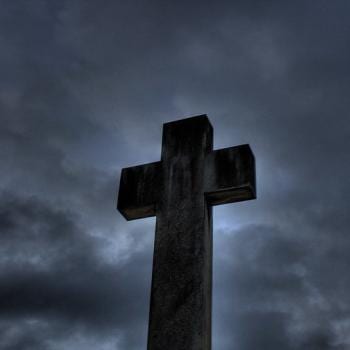Editors' Note: This article is part of the Patheos Public Square on Religion and Visual Art. Read other perspectives here.
I would like to share with you a profound experience I had with my artistic expression a few years go. It is about my Sophia drawings and what I discovered during the creative process. Here's a section from the introduction of my graphic book about her, The Liberation of Sophia:
I left the professional ministry and the church abruptly in the spring of 2010.
I'd finally had enough. I wanted to be free. I needed to be free. What I discovered, though, was that I was free all along. I simply needed to live it.
At the time my wife Lisa was working Friday and Saturday nights. So I had both of those nights to do my artwork in solitude. I have been an artist most of my life, usually focusing on producing moody watercolor landscapes. But, suddenly and without consciously knowing why, I found myself using pencils and pens. I was drawing these detailed images of a young girl or woman in various situations. She was usually nude and almost always seen from behind, engaging with nature, animals, birds, water, fish, the elements, but always essentially with herself.
 |
| Cave, David Hayward |
One evening, as I was drawing "Cave," I noticed an incredible amount of emotion within me. It was then I realized I was drawing my own journey, chronicling my own spiritual passage. I knew her name was Sophia and that she represented the pilgrimage from being trapped to being free. At the same time, I noticed how many people, especially women, were intrigued, inspired, and encouraged by her as I posted each image on my blog, nakedpastor.
It wasn't even really intentional. It was like a flow of consciousness. I only drew whatever I was inspired to draw whenever I was inspired to draw it. The images kept flowing for over two years until I had collected over fifty-five drawings. When I finished the last one, I knew I was done. It was finished. Sophia — that is, I — had finally found the freedom longed for.
So when you read the story of Sophia and see the drawings, you are seeing not only the journey of a young woman courageously struggling to achieve her own spiritual independence and gain her own freedom. You are also reading my story. This is about me. But it is also about so many of you who feel or felt trapped and want to do whatever it takes to be free.
Don't make the mistake, like I did, of assuming that liberation from captivity is easy. It's not. It is full of danger. But, if you journey it well you will come into a freedom like you've never known before. You have to adjust to it. I think this is why the moon plays a significant role in this story: it is the dark night of the soul. There is very little light, and any light is reflected light. But I can say that if you persevere, you will come into a light as bright as the sun — your own light.
I intentionally never show Sophia fully. We never see her face. That's because she is all of us.
Take the journey with me.
Years ago I read something about the theologian Karl Barth in Eberhard Busch's, Karl Barth: His Life from Letters and Autobiographical Texts. Barth preferred Mozart over Bach:
Barth's objection to Johann Sebastian Bach, otherwise so loved by theologians, was his all too deliberate, all too artificial "desire to preach," while Mozart attracted him because he was free from such intentions and simply played.
Barth talked about Mozart's "freedom." "He plays and does not cease to play," although he is aware of human finitude and death. Barth claimed that Mozart's music always spoke to him, not as gospel, but as "parables of the kingdom revealed in the gospel of God's free grace, and they continue to do so with the utmost freshness."




